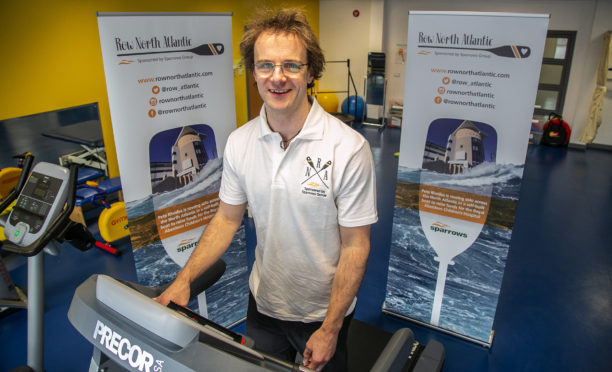An Aberdeenshire father-of-four will brave the dangers of the Atlantic Ocean as he aims to become the first person to complete a row across the water in a boat he made himself.
Peter Rhodes, a 35-year-old rope access manager at Sparrows group, has already started construction of the craft in his Alford garage ahead of his gruelling 2,000 mile nautical challenge in a year’s time.
He aims to raise £50,000 for Royal Aberdeen Children’s Hospital after its staff played a major role in saving his new-born son’s life last year.
Cedar, who turned one this week, was just nine-days-old when he fell ill and had to receive life-saving care to stabilise his condition in Aberdeen before being flown to Glasgow for emergency heart surgery.
The experience has inspired Mr Rhodes to raise money through the Grampian Health Board Endowment Fund, which will be used to provide additional amenities for the children’s hospital’s patients and staff, as well as research and equipment.
And as soon as Sparrows heard about his plans, they came on board as principal sponsor.
This has has allowed Mr Rhodes to begin building the six-metre long fibreglass vessel in his family garage.
Once at the final stages, he plans to complete the build at the Sparrows facility in Bridge of Don before taking it out for sea trails.
His trans-Atlantic journey is currently scheduled to start in May 2020 and is expected to take around 50 days – beginning at St Johns in Canada and rowing solo all the way to Oban.
He said: “More people have summited Mount Everest than rowed the Atlantic, so this challenge provides that opportunity.
“I’m extremely grateful for the support from my family and Sparrows.
“With four children under the age of six, my wife Kate is more understanding than most.
“I’m using a rowing machine to build my strength and endurance as I plan to complete the expedition in around 50 days.
“Tackling potential icebergs, storms, wind and waves will bring their own challenges, however the fundraising target and knowing my family will be waiting for me to celebrate in Oban will help to keep me focused and motivated.”
To sponsor Mr Rhodes effort, visit: www.rownorthatlantic.com/sponsorship, while personal donations can be made at www.justgiving.com/fundraising/rna.
Previous attempts
Completion of the 2,000 mile plus trip has proved to be one of the most difficult of nautical adventures- with over 200 unsuccessful attempts since 1990.
Sightings of 95-foot waves are not uncommon, making the North Atlantic crossing a treacherous one that provides a stern test for even the most experienced rowers.
Earlier this month, a hand-built wooden rowing boat was found of the coast of Norway six months after it was abandoned off Land’s End during an attempted Transatlantic crossing.
Duncan Hutchison, from Lochinver, spent three years constructing the craft before attempting to row it from New York to his home in the west Highlands.
He was rescued in September by a New York-bound tanker in rough seas and after his power supply failed having spent 100 days at sea and completed more than half of his journey.
For those looking to take on the cross-Atlantic challenge, preparation is absolutely essential – as is sticking to a strict fitness regime.
While on the water, sleeping patterns go out the window, consistent rowing is essential, and rest is reliant on a fortuitous current.
As a result of this, hopefuls must have an outstanding level of fitness as well as broad knowledge of the challenges they can expect to face.
Volatile weather and boat endurance must be considered before any handmade vessel takes to the seas, with rigorous testing and practice essential for the completion of what is a mammoth task.
It is by no means impossible, however, with almost 300 people having successfully navigated the route since John Fairfax’s inaugural solo row in 1969.










